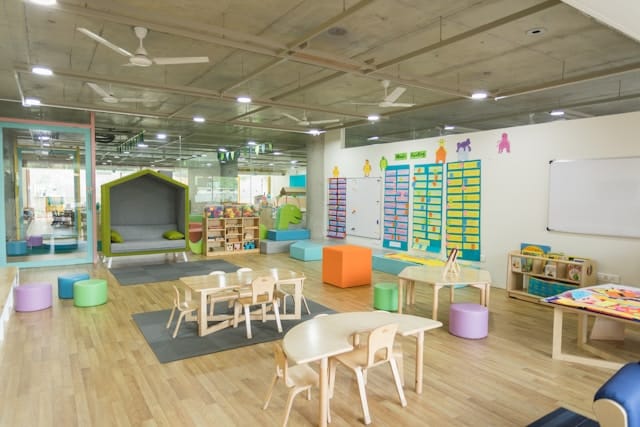How to Set Up a Safe and Inviting Home Daycare for Multiple Age Groups?

A home daycare is more than a business, it’s a service of love, care, and learning. It’s about creating a safe and nurturing space where children can grow, play and explore the world around them. This article will guide you through the process to create a home daycare setup that caters to children of multiple age groups. We will delve into the importance of environment, storage, and classroom spaces, and how to ensure your daycare center is a haven for both children and their families.
Creating a Safe Environment
To create a home daycare, the first task you must embark upon is ensuring the environment is safe for the children you will be caring for. A safe environment goes beyond just child-proofing your home. It encompasses everything from the physical setup to the type of materials and toys available.
Also to read : What Are the Best Moisture-Resistant Materials for a Basement Home Gym?
Start by examining your space. Is there enough room for children to move around freely without bumping into furniture or each other? Are all electrical outlets covered and corners padded to prevent accidents? Are cleaning supplies and medicines stored out of reach of children?
Next, consider the materials and toys. They should be age-appropriate and free of choking hazards. For babies and toddlers, choose toys that are large enough not to be a choking hazard, and for older children, ensure there are enough stimulating and educational toys to keep them engaged.
Have you seen this : How Can You Design a Home Theater with Acoustic Panels for Optimal Sound?
Designing Engaging Learning Spaces
A home daycare should be more than just a space for children to play. It should also be a learning environment. This is where classroom spaces come into play. Classroom spaces are areas within your daycare where children can engage in structured learning activities.
Craft a separate area for reading, stocked with age-appropriate books. Create a space for art and craft activities, ensuring it is easy to clean up after the inevitable messes. If space allows, a small science corner with age-appropriate experiments can be a fantastic learning tool as well.
While designating these spaces, remember to keep flexibility in mind. Children’s interests and needs can change rapidly, and your spaces should be able to adapt to these changes.
Facilitating Child-Friendly Storage
In a daycare center, storage plays a crucial role. Not only does it help keep the space clean and organized, it also teaches children about responsibility and order.
Firstly, storage spaces should be accessible to children. They need to be able to reach and return their toys and materials easily. This will encourage them to take care of their belongings and learn about responsibility. Secondly, storage should be labeled clearly, with pictures for younger children who cannot read yet.
It’s also important to maintain a designated space for each child’s personal belongings, such as coats, bags and lunch boxes. This helps children to feel a sense of belonging and respect for the personal space of others.
Fostering a Homely Environment
A daycare is a child’s home away from home. Therefore, it should feel warm, inviting and comfortable. Soft lighting, cozy seating areas, and familiar objects can help create a homely environment.
It’s vital to have a quiet and comfortable spot for children to relax, nap or have some alone time. A small nook with a soft rug, cushions, and a few books can serve this purpose well.
The décor of your daycare should also reflect the children who are a part of it. Displaying their artwork, photos of them with their families or any projects they’ve worked on makes them feel valued and proud.
Involving the Families
In running your daycare, never forget that you are not only a part of the children’s lives, but also their families’. Keeping open lines of communication with parents and involving them in their child’s daycare life will build a strong relationship between you and the families you serve.
Host family events at your daycare, such as potlucks, family game nights, or parents’ meetups. This encourages a sense of community and gives parents an opportunity to get to know each other and the environment their child spends time in.
When setting up your home daycare, always remember that it’s a continuous process. The needs of the children and their families, as well as your own, will change over time. Always be flexible and ready to adapt to these changes, ensuring your daycare remains a safe, inviting and engaging place for everyone involved.
Maintaining a Well-Designed Floor Plan
A well-designed floor plan is an essential component of a successful home daycare. It is the blueprint that guides the arrangement and interaction of spaces in your daycare center. It informs how children and adults move within the space, contributes to the safety of the environment, and plays a crucial role in determining the overall functionality of your daycare.
Your floor plan should cater to the needs of the different age groups you will accommodate in your daycare. For infants, a quiet, cozy, and safe space away from the busy areas is crucial. This space should include a comfortable area for sleeping, a changing station, and a play area with toys and materials appropriate for their age and developmental stage.
Toddlers require a different setup. They are mobile and curious, so spaces for them should promote exploration and independence. Easy access to toys, books, and materials is essential, along with plenty of room to move and play. Consider a low table and chairs for meals and activities, a small couch for relaxing, and a quiet corner for downtime.
For older children, the floor plan should include areas for more complex play and learning activities. This includes a reading corner, an arts and crafts area, and a dedicated space for homework or projects.
Remember, your floor plan should promote safety, accessibility, and flow. Make sure pathways are clear, and areas are designated for specific activities, with storage within reach to encourage self-help skills. It’s also crucial to consider the visibility of all areas for adults to easily supervise children at all times.
Adapting to Mixed Age Dynamics
Running a home daycare for mixed age groups presents unique challenges and rewards. Younger children can learn from older ones, while older children can develop empathy and leadership skills. However, effectively managing mixed age dynamics requires thoughtfulness and careful planning.
When planning activities, consider the different developmental stages and interests of the children. Provide a variety of age-appropriate toys and materials that cater to their varied needs. For example, simple blocks can be used by toddlers for stacking, while older children can use them for more complex building projects.
It’s also essential to teach older children about the safety and gentleness when playing with younger ones. Encourage them to help out and mentor the younger ones, fostering a sense of responsibility and community.
Implement a flexible routine that caters to the needs of different age groups. Young children may need more nap times, while older children may need time for homework or quiet reading. Be aware of these needs and structure your day accordingly.
Conclusion: Creating an Environment That Grows with Children and Families
In conclusion, setting up a home daycare for multiple age groups is undoubtedly a challenging task. However, with careful planning, adaptability, and a deep understanding of children’s needs, it can be a rewarding experience. A well-designed environment that promotes safety, learning, and exploration can significantly impact the children’s overall growth and development.
Remember, a home daycare is a dynamic space. It must evolve and adapt to the changing needs of the children and their families. As the children grow, their needs and interests will change, and your daycare center should be flexible enough to accommodate these changes.
Finally, never underestimate the importance of building strong relationships with the children’s families. They are your partners in ensuring the well-being and development of the kids. Engage them, keep them informed, and involve them in their child’s daycare life. A home daycare that fosters strong relationships with families is a daycare that thrives.
